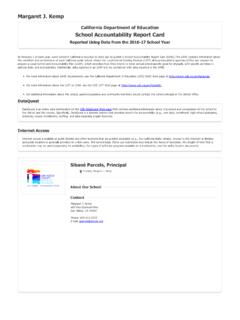Transcription of The Attendance Matters Project
1 1 The Attendance Matters Project November 4, 2016 Todd Rogers, Harvard University Nancy Magee, San Mateo County Office of Education Carly Robinson, Harvard University Monica Lee, Stanford University Gonzalo Pons, Harvard University 2 Executive Summary Across 14 school districts in San Mateo County, a total of 30,084 households were involved in the Attendance Matters Project . The Project consisted of four different studies, all of which were randomized controlled trials: 1) Grades K-5 absence-reduction study; 2) Grades 6-12 symbolic awards study, 3) Grades 6-12 siblings study, and 4) consent form study. All four studies used mailings to test strategies for communicating with families. The grades K-5 absence-reduction study targeted parent beliefs about Attendance , while the grades 6-12 studies both targeted students directly by offering symbolic awards for improved Attendance . Lastly, the consent form study explored parents attitudes towards education research.
2 Mailings were sent in English or Spanish based on the student s home language as reported in district data. In the following report, we focus on the primary study, the grades K-5 absence-reduction study (the driving motivation for this Project ). We also discuss the grades 6-12 symbolic awards study. Details regarding the consent form study and the grades 6-12 siblings study can be found in Appendix B. The Attendance Matters Project was successful on two fronts. First, the Project improved Attendance for elementary school students. The grades K-5 absence-reduction study significantly decreased absences by more than one half of a day of school per student. The reduction in absences occurred across all K-5 student subgroups, and was most effective for the most at-risk students, decreasing chronic absenteeism by 16%. Second, the Project shed light on one common educational practice. The grades 6-12 symbolic awards study tested whether awards can motivate middle school and high school students to attend school more.
3 Awards are commonly used by educators to incentivize students. We find that Attendance is generally not a measure that can be motivated by symbolic awards, and that these awards can even be de-motivating when given as surprises for past performance. 3 The Attendance Matters Project was supported in part by grants from the Heising-Simons Foundation, the Silicon Valley Community Foundation, and the Laura and John Arnold Foundation. This Project would not have been possible without the support of the research team and participating school districts in collaboration with the San Mateo County Office of Education. We thank Anne Campbell, San Mateo County Superintendent of Schools, as well as Nancy Magee, Associate Superintendent of the Student Services Division, for their enthusiastic support and partnership throughout the duration of this study; Deann Walsh and Cameron Lewis for their assistance and expertise on San Mateo County student data; and the 14 participating districts within San Mateo County, as well as each respective superintendent and data specialist, for their collaboration on this Project .
4 In addition to the San Mateo County Office of Education, we are grateful for Jessica Mihaly of the Silicon Valley Community Foundation, Hedy Chang of Attendance Works, and the Ad Council for their assistance on content development & design for the Grades K-5 absence-reduction study. Our study has also benefited greatly from thoughtful contributions by Eric Dearing, Professor of Applied Developmental Psychology at Boston College, and Jana Gallus, Assistant Professor at UCLA Anderson School of Management. 4 About the Research Team Student Social Support R&D Lab The Student Social Support Research & Development Lab (S3 Lab) develops scalable interventions that mobilize and empower students social support systems to improve achievement. We do so by leveraging four recent developments: New behavioral insights. Behavioral economics and psychology have uncovered powerful levers of behavior change that are only recently being applied to social problems.
5 Improved data and communications. With comprehensive data systems, new digital learning platforms, and increasingly scalable communications, we can now send low-cost, rapid, targeted, and tailored educational interventions to students and parents. Fast-cycle, low-cost randomized studies. Sometimes called A-B testing, rapid experiments allow for fast and cost-effective learning and innovation. Mounting evidence about the influence of friends and family on student achievement. Interventions aimed at students friends and family can be more cost-effective at increasing student achievement than targeting students themselves or teachers. The S3 Lab s work falls into three buckets: Connecting parents to what s happening in class Connecting other adults who care about the student with the student s education Correcting parents miscalibrated beliefs This work is conducted in more than 1,400 educational settings including K-12 schools, online universities, state and community colleges, and Massive Open Online Courses (MOOCs).
6 Professor Todd Rogers Todd Rogers, , is an Associate Professor of Public Policy at the Harvard Kennedy School (HKS) and director of the Student Social Support R&D Lab. He is also Senior Researcher at the think tank ideas42. Professor Rogers is a behavioral scientist whose research sits at the intersection of education, psychology, judgment and decision-making, and behavioral economics. Prior to joining the faculty at HKS, Todd Rogers was founding Executive Director of the Analyst Institute, LLC, which uses randomized field experiments and behavioral science insights to understand and improve voter communications. He received his jointly from Harvard's 5 department of Psychology and Harvard Business School and received his from Williams College, majoring in Religion and Psychology. Partnerships The Attendance Matters Project was a research Project in partnership with the San Mateo County Office of Education (SMCOE), The Big Lift (described below), and 14 school districts within San Mateo County.
7 The 14 partnering districts were as follows: Bayshore Elementary School District Belmont-Redwood Shores School District Brisbane School District *Cabrillo Unified School District Hillsborough City School District *Jefferson Elementary School District Jefferson Union High School District *La Honda-Pescadero Unified School District Millbrae School District Pacifica School District San Mateo-Foster City School District San Mateo Union High School District Sequoia Union High School District *South San Francisco Unified School District *Districts participating in The Big Lift The Big Lift The Big Lift is a collaborative effort led by the Silicon Valley Community Foundation, the county of San Mateo, and the San Mateo County Office of Education to close the achievement gap countywide. Funded in part by local tax dollars and the Social Innovation Fund, the Big Lift s collective impact model asks school districts to partner with public and private preschools and community-based agencies to work toward the long-term goal of achieving proficiency in reading for third-graders through the four programmatic pillars of the Big Lift, based on the Campaign for Grade-Level Reading priorities.
8 The Big Lift s four pillars are as follows: School Readiness: a goal of increasing the percentage of children ready for kindergarten from 50% to 80% 6 Attendance Matters : a goal of reducing the incidence of chronic absenteeism by 50% Inspiring Summers: a goal of 80% of kids who are reading below grade level attending a quality summer enrichment program Family and Community Engagement: a goal of strengthening approaches and strategies to ensure greater family engagement 7 Motivation for the Attendance Matters Project The Attendance Matters Project is a research Project examining how best to communicate to students and families about the importance of regular school Attendance , with a goal of identifying best practices for low-cost, scalable interventions to reduce student absenteeism in San Mateo County. Because there is no one-size-fits-all strategy to improve Attendance , this Project employed several different strategies motivated by research on behavior change.
9 Why focus on Attendance ? Simply put, educators, families, policymakers, and researchers all agree that Attendance is a key factor in student success. School Attendance strongly predicts academic achievement, and is also among the strongest predictors of eventual high school graduation (Balfanz & Byrnes, 2012; Byrnes & Reyna, 2012). Given the strong connections among absenteeism, academic achievement, and high school graduation (Gottfried, 2009), one of the most effective strategies for increasing student success is a concerted effort to increase student Attendance (Byrnes & Reyna, 2012). While research on the academic success continuously affirms the importance of attending school each day ( Attendance is the A of the ABCs of dropout prevention: Mac Iver & Mac Iver, 2009), school districts and administrators lack evidence-based interventions that can help them get students to school. This may even become a financial matter for many districts, where each absence results in less funding for their schools based on Average Daily Attendance (ADA).
10 In particular, we targeted grades K-5 and grades 6-12 with different studies, because we know that age Matters when it comes to engaging parents and students. The grades K-5 absence-reduction study was built on research about how families are often less aware of the critical importance of Attendance in the elementary school years. Furthermore, many parents have miscalibrated beliefs about how many days of school their child has actually missed. The grades 6-12 study capitalized on research about the motivating influences of symbolic awards ( , certificates sent in the mail). A small study recently found that symbolic awards can increase Attendance in an out-of-school tutoring setting (Springer, Rosenquist, & Swain, 2015). Building on this research, the grades 6-12 study determines whether prospective ( , you will receive a certificate if you achieve perfect Attendance this month ) or retrospective ( , you received a certificate because you have already achieved perfect Attendance in a previous month ) symbolic awards are more effective, and whether symbolic awards increase Attendance because of what they signify to the student, or because of the knowledge that school leaders ( , students principals and superintendent) are sent a list of which students earned the symbolic award.







